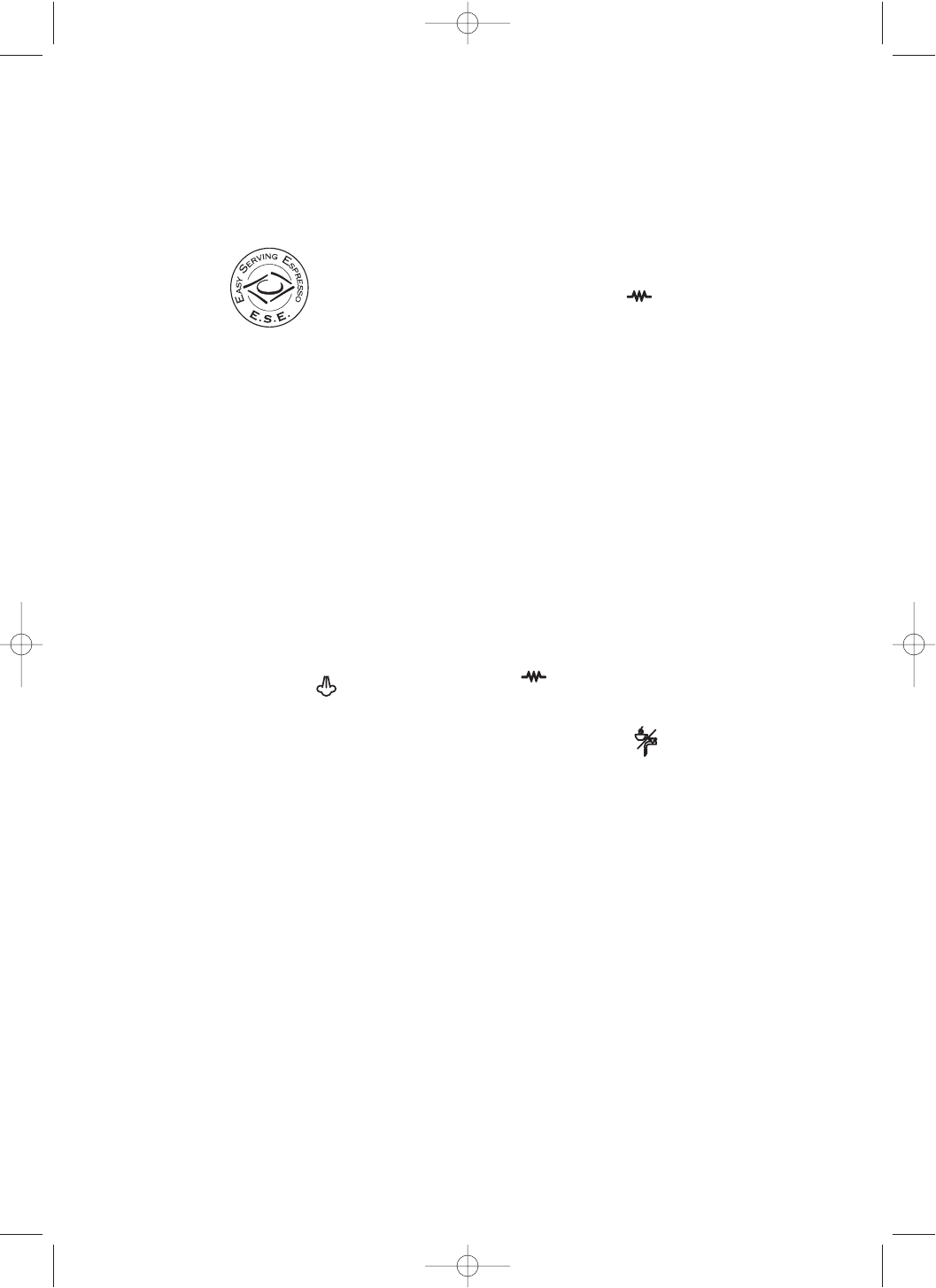
HOW TO PREPARE ESPRESSO COFFEE USING PODS
(FOR APPLIANCES WITH TWO FILTERS ONLY)
1.Preheat the appliance as described in the section
"PREHEATING THE COFFEE UNIT", making sure the
filter holder is attached.
NOTE: use pods conforming to the ESE standard,
indicated on the pack by the following symbol:
The ESE standard is a system accepted by leading pod
producers and enables espresso coffee to be prepared
simply and cleanly.
2.Place the small 1 coffee or pod filter in the filter
holder, making sure the projection is correctly
inserted in the slot as shown in fig. 12.
3.Insert a pod, centering it as far as possible on the
filter (fig. 15).Always follow the instructions on the
pod pack to position the pod on the filter correctly.
4.Attach the filter holder to the appliance. Always
rotate as far as it will go (fig. 6).
5.Proceed as in points 5, 6 and 7 in the previous
paragraph.
HOW TO MAKE CAPPUCCINO COFFEE
1.Prepare the espresso coffees as described in the
previous paragraphs, using sufficiently large cups.
2.Rotate the selector knob to the position (fig. 16)
and wait until the OK light comes on (fig. 7). This
indicates that the boiler has reached the ideal
temperature for steam production.
3.In the meantime, fill a container with about 3
1
/
2
ounces of milk for each cappuccino to be prepared.
The milk must be at refrigerator temperature (not
hot!). In choosing the size of the container, bear in
mind that the milk doubles or triples in volume.
Note: You are recommended to use skim milk at
refrigerator temperature.
4.Place the container with milk under the Jet Frother
(fig. 17).
5.Immerse the Jet Frother in the milk about 1/4 of an inch
and rotate the steam knob counter-clockwise (fig. 18)
(rotating the knob more or less varies the quantity of steam
discharged by the Jet Frother). The milk now starts to
increase in volume and take on a creamy appearance.
6.When the milk has doubled in volume, immerse the
Jet Frother deeply and continue heating the milk (fig.
19). When the required temperature is reached (the
ideal is 60°C - 140°F), interrupt steam delivery by
rotating the steam knob clockwise and placing the
selector in the "O" position (fig. 14).
7.Pour the frothed milk into the cups containing the
espresso coffee prepared previously.
The cappuccino is ready. Sweeten to taste and if
desired, sprinkle the froth with a little cocoa powder.
Note: to make coffee again after the milk has been
frothed, cool down the boiler first or the coffee will
burn. To cool, place a container under the boiler
outlet, turn the selector to the "coffee" position and
run off the water until the OK light goes out. Turn the
selector back to the position and make the coffee
as described above.
IMPORTANT: always clean the Jet Frother after use.
Proceed as follows:
1.Discharge a little steam for a few seconds by rotating
the steam knob (fig. 18).
2.Wait several minutes for the steam tube to cool
down. Unscrew the cappuccino maker by rotating
clockwise (fig. 20) and wash thoroughly with warm
water.
3.Make sure the three holes in the cappuccino maker
shown in fig. 21 are not blocked. If necessary, clean
with a pin.
4.Clean the steam tube, taking care to avoid burns.
5.Screw the cappuccino maker back in place.
HOT WATER PRODUCTION
1.Turn the appliance on by rotating the selector knob to
the position (fig. 5).
2.Place a container under the cappuccino maker.
3.When the OK indicator light comes on, turn the
selector knob to the position (fig. 8) and at the
same time, rotate the steam knob counter -clockwise
(fig. 18). Hot water is delivered from the Jet Frother.
4.To interrupt delivery of hot water, rotate the steam
knob clockwise and position the selector knob to "O"
(fig. 14).
CLEANING AND MAINTENANCE OF THE
FILTER
About every 300 coffees or when the coffee drips out
of the filter holder or not at all, clean the ground coffee
filter holder as follows:
• Remove the filter from the filter holder.
• Remove the filter cap (fig. 22) by unscrewing in the
direction indicated by the arrow on the cap.
• Remove the frother from the container by pushing it
from the cap end.
• Remove the gasket (fig. 25).
• Rinse all components and clean the metal filter
thoroughly in hot water using a brush (fig. 23).
Make sure the holes in the metal filter are not
blocked. If necessary, clean with a pin (see fig. 24).
9
EC190/200 GB 6-12-2004 12:38 Pagina 9














